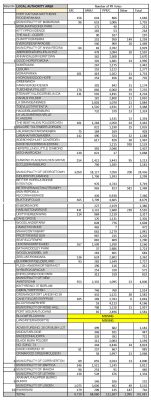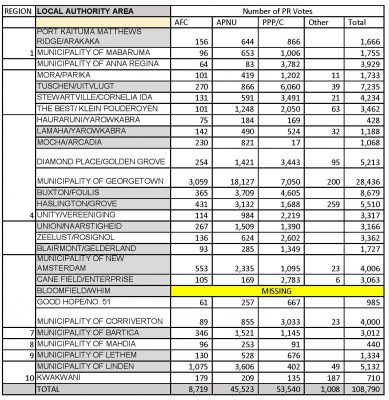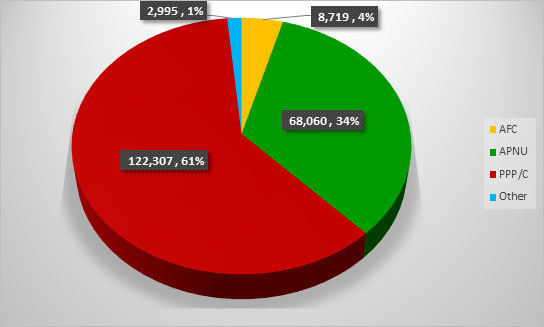Official results declared by the Guyana Elections Commission (GECOM) for the November 12th local government polls have confirmed a major win for the opposition PPP/C, which secured 61% of the votes, while APNU, the main partner in the governing coalition, managed 34%.
In its solo outing at the polls, the Alliance For Change (AFC), the other partner in the governing coalition, was able to amass 8,719 votes, representing 4% of the total number of votes cast, according to the official results.
The AFC’s showing attracted interest as it was meant to compete with the opposition PPP/C on the Corentyne and West Berbice. The AFC, however, suffered heavy defeats in these areas. The AFC’s performance has also drawn public attention as its leadership asserted that it had maintained its showing at around 10% of the national vote. This is not so as it gained only 4% of the total vote though its percentage from the 27 Local Authority Areas it contested in was around 8%.

An extraordinary gazette, dated November 21st, was yesterday issued with complete results for 78 of the 80 Local Authority Areas (LAAs) where polls were held on November 12th. The number of votes cast as part of the Proportional Representation (PR) and First-Past-the-Post (FPTP) components of the elections have been declared for all LAAs except Bloomfield/Whim and Lancaster/Hogstye. The PR results for these two areas have not been declared.
According to the results, of the 202,081 valid PR votes cast, the People’s Progressive Party/Civic (PPP/C) amassed 122,307, while A Partnership for National Unity (APNU) secured 68,060 and the AFC managed 8,719. The various voluntary groups which contested in specific LAAs cumulatively attracted 2,995 votes.
These figures show that the opposition PPP/C was able to attract in excess of 54,000 votes more than its closest competitor, APNU, or 60.5% compared to 33.7%. The AFC secured 4.3% of the total votes gazetted.
Following the elections, the AFC had claimed that based on its own preliminary analysis, the party moderately increased its support among Guyanese from the 10.32 percent which it registered at the 2011 general elections, when it last contested independently.
In a press release issued on November 15th, the AFC assured Guyanese that the party had consolidated and in fact maintained its support across Guyana.
“Voter turnout was low and the initial results were not as projected, and fell below the party’s expectations… [however] once all the results are officially announced by GECOM, the AFC is confident that it will maintain its share of the vote in the various constituencies in which it contested,” the release concluded.
The results do not however support this claim. The party contested in 27 of the 78 LAAs which have had their results announced. In those 27 LAAs, a total of 108,790 PR votes were cast and the AFC captured 8% of that number. The PPP/C was able to secure 49% of the votes cast in these areas, while APNU secured 42%.
The strongest showing from the party was recorded in the Kwakwani LAA, where it secured 25% of votes cast and one of four PR seats. In Linden, 21% of those who cast valid ballots selected the AFC, granting the fledgling party two of eight PR seats. Similarly, in Mocha/Arcadia, 22% of votes cast saw the party awarded one of six PR seats.
In total, of the 596 PR seats available, the AFC secured 14 or 2%. Three of the 596

FPTP seats available were also snapped up by AFC candidates Orvil August and Natasha Mohamed in Constituencies 4 and 5 of Kwakwani, and Amanda Solomon in Constituency 4 of Mahdia.
Notably, Solomon was not challenged and therefore won via No Contest, while Mohamed secured the same number of votes as Petranella Pollard of Kwakwani United for Progress (KUFP). When lots were drawn to break the tie, Mohamed emerged victor.
GECOM has put total voter turnout for this year’s polls at a mere 36.3% or 208,534 of the 573,923 eligible voters, representing a more than 10% decline from the 47.1% recorded for the 2016 local polls. At the time of those elections, 239,070 of the 507,584 persons eligible to vote cast their ballots. Based on these figures, this year’s polls saw over 30,000 fewer voters.






